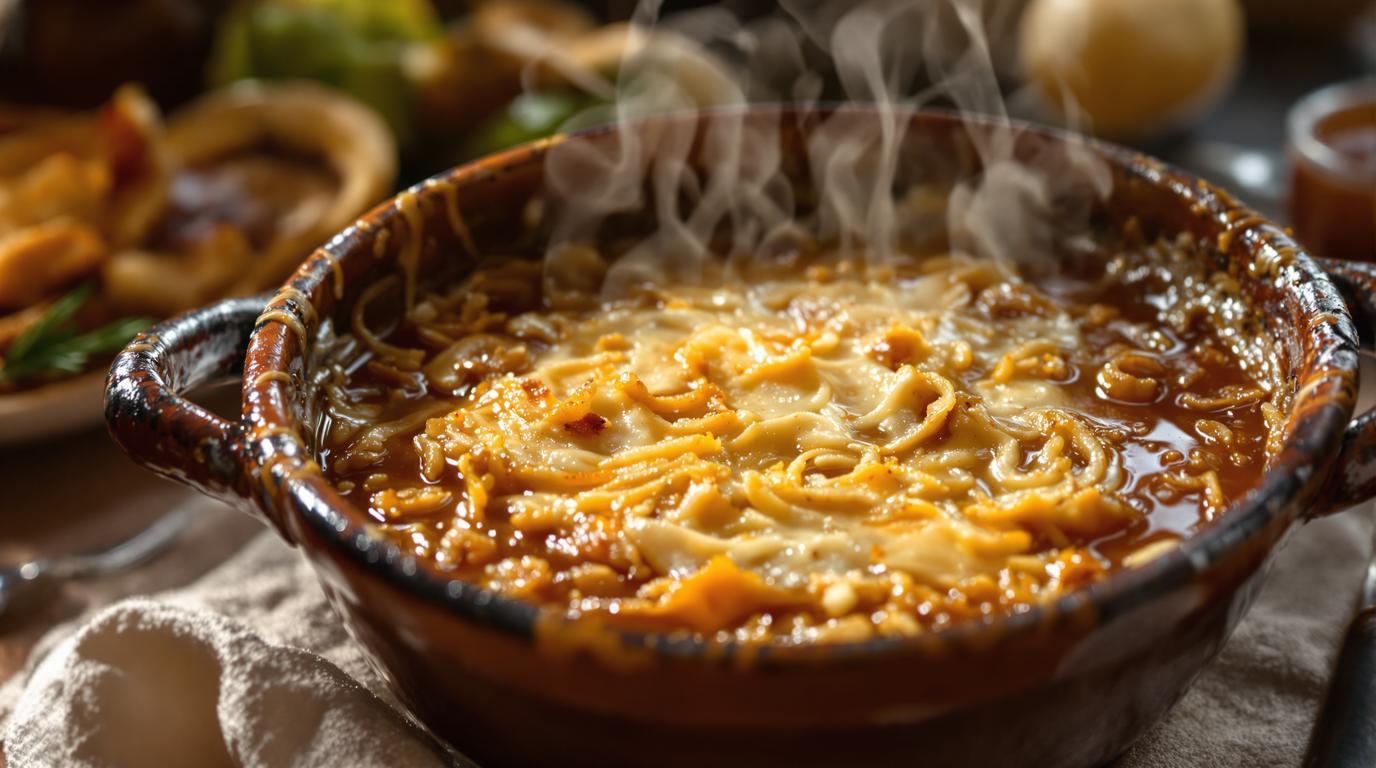There’s something undeniably magical about French onion soup that transcends its humble ingredients. Growing up, I watched my grandmother transform plain yellow onions into sweet, caramelized jewels through nothing but patience and a weathered cast iron pot. The alchemy of this classic dish isn’t found in exotic ingredients but in technique – particularly the slow dance of caramelization that transforms sharp onions into a deeply sweet, complex base that defines authentic Soupe à l’Oignon. This traditional Île-de-France recipe has been passed through generations, with each family claiming their own secret touch. Mine? A splash of cognac added during the final moments of caramelization – just as my grandmother taught me.
The Story Behind Traditional French Onion Soup 📖
This quintessential comfort food originated as a peasant dish in medieval France, where onions were plentiful and affordable. What we now consider a bistro classic was once sustenance for field workers, evolving over centuries into the gratinéed masterpiece we know today. While Paris bistros might favor Gruyère, traditional home cooks in Île-de-France often use aged Comté, adding a nutty depth to the dish. The current iteration – with its crown of bubbling cheese – gained popularity in the 18th century among late-night market workers at Les Halles in Paris, where it served as restorative nourishment after long shifts.
Essential Ingredients 🧾
The magic of French onion soup lies in its minimalism – just a handful of quality ingredients that transform through technique:
- 1½-2 lbs (700g-1kg) brown onions, sliced into thin half-moons (3mm ideal)
- 3 tablespoons unsalted butter
- Bouquet garni (1 thyme sprig, 1 bay leaf, 1 celery stalk, 1 leek green, chives)
- 2 quarts (2L) quality beef stock
- 4 slices baguette (1cm thick)
- 7 oz (200g) Comté or Gruyère cheese, grated
- Salt and freshly ground pepper, to taste
Step-by-Step Instructions 📝
The soul of this soup is patience – rushing caramelization creates merely browned onions, not the deeply transformed morsels we’re after:
- Melt butter in a heavy-bottomed Dutch oven or cast iron pot over medium heat.
- Add sliced onions, stirring to coat with butter. Reduce heat to low, cover, and let sweat for 15 minutes.
- Uncover, slightly increase heat, and begin the caramelization process. Stir every 5 minutes, using a wooden spoon to gently scrape fond from the bottom. This process should take a full hour – resist the urge to rush.
- Meanwhile, bring beef stock to a simmer with the bouquet garni in a separate pot. Let infuse for 30 minutes.
- When onions reach a rich amber color, pour hot stock over them, stirring to release any caramelized bits from the pot’s bottom.
- Simmer the soup for 25 minutes at a gentle bubble.
- Prepare croûtons by brushing baguette slices with olive oil and toasting until golden.
- Ladle soup into oven-safe bowls, top with croûtons and a generous layer of grated cheese.
- Broil for 5-7 minutes at 400°F (200°C) until cheese forms a bubbly, golden crust.
Chef’s Secret Techniques 🤫
After decades in professional kitchens, I’ve collected techniques that elevate this classic:
Chef’s Note: The difference between good and transcendent onion soup lies in caramelization patience. When onions begin sticking too much, deglaze with a tablespoon of water rather than increasing stirring, which cools the pan. A single pinch of sugar can help stubborn onions along, but use sparingly – we want natural sweetness.
For maximum flavor development, infuse your bouquet garni in the stock for a full hour before adding to the onions. This creates layers of herbal complexity that simply can’t be rushed. And never over-salt early – as the soup reduces, flavors concentrate. Season only in the final stages of cooking.
For a rustic countryside variation, try butter-soaking your bread before toasting – a technique my grandmother swore by for creating a rich barrier between soup and cheese that adds remarkable depth.
Serving & Presentation Tips 🍽️
Serve this soul-warming soup immediately after gratinéing, while the cheese remains stretchy and the contrast between molten topping and rich broth is most pronounced. Pair with a crisp Sancerre whose acidity cuts through the richness, or a medium-bodied Côtes du Rhône that complements the caramelized flavors.
For a complete meal, accompany with a simple green salad dressed with light vinaigrette – the acidity provides perfect contrast to the soup’s richness. In summer months, consider serving alongside my Greek Yogurt Tzatziki Pasta for a refreshing counterpoint, or in cooler weather, my Harissa-Spiked Moroccan Chickpea Stew creates a warming feast.
The beauty of this ancestral recipe lies not in flashy ingredients or complicated techniques, but in honoring time-tested methods. As my grandmother would say, “A good soup is like a good friend – it doesn’t need to be fancy to warm your soul.” I hope this classic brings as much comfort to your table as it has to mine for decades. For summer alternatives that deliver equal comfort with seasonal flair, explore my Chilled Ramen or finish your meal with nostalgic Homemade Ice Pops.
